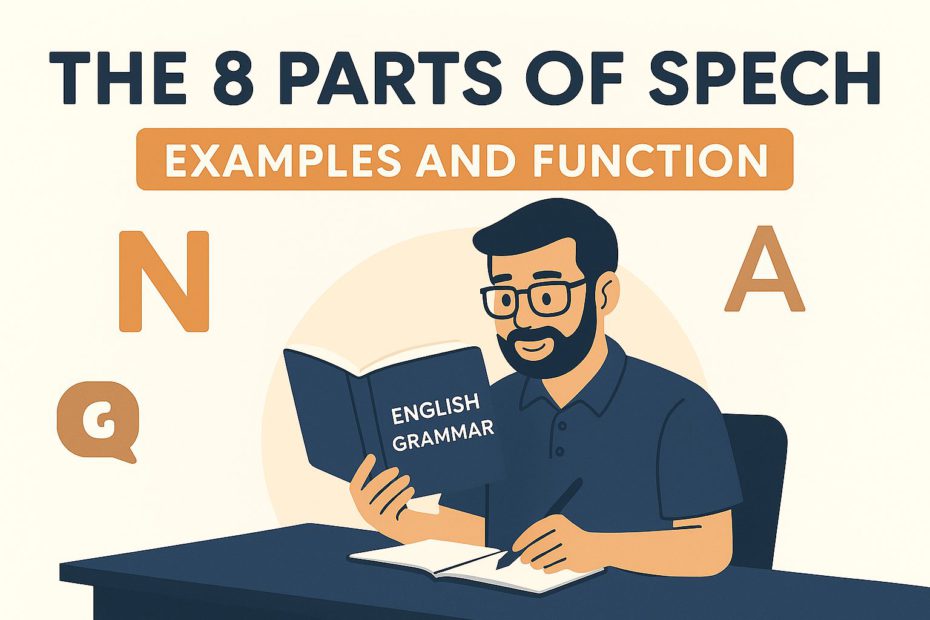Understanding the eight parts of speech is essential for anyone aiming to communicate effectively in English. These categories are the foundation of sentence structure and word function, allowing us to convey precise meaning and maintain grammatical correctness in both writing and speech.
This guide offers an in-depth, expert explanation of each part of speech, along with examples and usage tips to help you gain complete mastery.
📌 What Are the 8 Parts of Speech?
The eight parts of speech in English are:
- Nouns
- Pronouns
- Verbs
- Adjectives
- Adverbs
- Prepositions
- Conjunctions
- Interjections
Each plays a unique role in a sentence. Let’s examine them one by one.
🟨 1. Nouns: Naming Words
A noun is your naming powerhouse — it tags everything around you, from people and places to ideas and vibes.
🔍 Types of Nouns:
- Common nouns: cat, city, teacher
- Proper nouns: Alice, Pakistan, Google
- Concrete nouns: apple, chair, tree
- Abstract nouns: honesty, freedom, love
- Collective nouns: team, family, class
- Countable & uncountable nouns: book(s), water
✅ Example:
“Creativity is essential in modern business.”
📚 Pro Tip: Nouns can function as subjects, objects, or complements in a sentence.
🟩 2. Pronouns: Noun Substitutes
Pronouns act as powerful substitutes in your sentences, replacing nouns to avoid unnecessary repetition and keep your writing smooth and clear.
🧩 Types of Pronouns:
- Personal: I, you, he, she, it, we, they
- Possessive: mine, yours, his, hers, ours, theirs
- Reflexive: myself, yourself, themselves
- Demonstrative: this, that, these, those
- Relative: who, which, that
- Indefinite: anyone, something, each
✅ Example:
“They visited the museum due to their passion for history.”
🧠 Grammar Tip: Ensure pronoun-antecedent agreement (in both number and gender).
🟥 3. Verbs: The Heart of a Sentence
A verb is a fundamental part of speech that indicates an action, an event, or a state of being—and every complete sentence must include at least one.
🔧 Verb Categories:
- Action verbs: jump, build, write
- Linking verbs: seem, become, be
- Helping (auxiliary) verbs: have, do, can, will
✅ Example:
“She has completed the project ahead of time.”
⚠️ Watch for verb tense consistency in longer sentences.
🟦 4. Adjectives: Descriptive Modifiers
An adjective is a word that adds detail or description to a noun or pronoun, helping to clarify or enhance its meaning. It adds detail by answering: What kind? Which one? How many?
🎨 Examples:
- Red (color)
- Tall (height)
- First (order)
- Several (quantity)
✅ Example:
“The brilliant scientist received an award.”
💡 Expert Note: Adjectives often precede the noun but can also follow linking verbs (e.g., “She is happy“).
🟪 5. Adverbs: Describing Verbs and More
An adverb is a word that provides more information about a verb, adjective, or another adverb—typically describing how, when, where, or to what degree something happens.
🌀 Examples:
- Quickly (how)
- Today (when)
- Outside (where)
- Extremely (to what extent)
✅ Example:
“He spoke softly to avoid waking the baby.”
💡 Pro Tip: While many adverbs are easy to spot with their –ly ending (like quickly or happily), not all follow this pattern—words like fast, well, and hard are also adverbs!
🟫 6. Prepositions: Showing Relationships
A preposition connects a noun or pronoun to another word, showing relationships like direction, location, time, or cause.
🔗 Common Prepositions:
in, at, on, under, beside, during, through, because of
✅ Example:
“The files are in the cabinet next to the printer.”
📎 Structure: Prepositions are always part of a prepositional phrase: preposition + object (e.g., under the table).
🟧 7. Conjunctions: Connecting Words and Ideas
Conjunctions are the connectors in a sentence—they join words, phrases, or clauses to help ideas flow smoothly and logically.
📌 Types of Conjunctions:
- Coordinating conjunctions are used to link words, phrases, or independent clauses that are grammatically equal. The acronym FANBOYS makes them easy to remember:
F – for
A – and
N – nor
B – but
O – or
Y – yet
S – so - Subordinating: although, since, while, because
- Correlative: either/or, neither/nor, not only/but also
⚖️ Expert Advice: In compound sentences, use a comma before a coordinating conjunction.
🟨 8. Interjections: Expressing Emotion Instantly
An interjection is a word or phrase that expresses strong emotion or sudden reaction. These are typically informal and often set apart by an exclamation point.
💥 Examples:
- Wow!
- Oh no!
- Hey!
- Hurray!
✅ Example:
“Wow! That performance was incredible.”
🧩 Grammar Note: Interjections stand alone—they aren’t grammatically connected to the sentence structure, but they add emotion or emphasis.
📊 Summary Table: The 8 Parts of Speech at a Glance
| Part of Speech | Function | Example |
|---|---|---|
| Noun | Names a person, place, thing, or idea | The student read a book. |
| Pronoun | Replaces a noun | She is reading. |
| Verb | Shows action or state | He ran fast. |
| Adjective | Describes a noun | The blue car |
| Adverb | Describes how, when, where | She sings loudly. |
| Preposition | Shows direction, place, time, cause | The bag is under the table. |
| Conjunction | Connects words/phrases | I want tea and coffee. |
| Interjection | Expresses emotion | Oops! I spilled it. |
📘 Why the Parts of Speech Matter
Grasping the parts of speech is more than a grammar formality. It helps you:
✅ Write grammatically correct sentences
✅ Understand what’s wrong when editing
✅ Improve your fluency and vocabulary
✅ Master other languages with ease
Even native English speakers benefit from understanding these categories—especially when tackling complex writing or editing tasks.
✍️ Final Thoughts
Language is a tool, and knowing how it works makes you a more powerful communicator. The eight parts of speech are the essential building blocks that shape every sentence in the English language. As you practice identifying and using them, your writing will become more polished, your speaking more confident, and your understanding of English grammar rock solid.
So the next time you write a sentence, ask yourself:
👉 What role does each word play?
The more you practice, the more intuitive grammar becomes. Stick with it—you’re building a strong foundation. 💪📖

